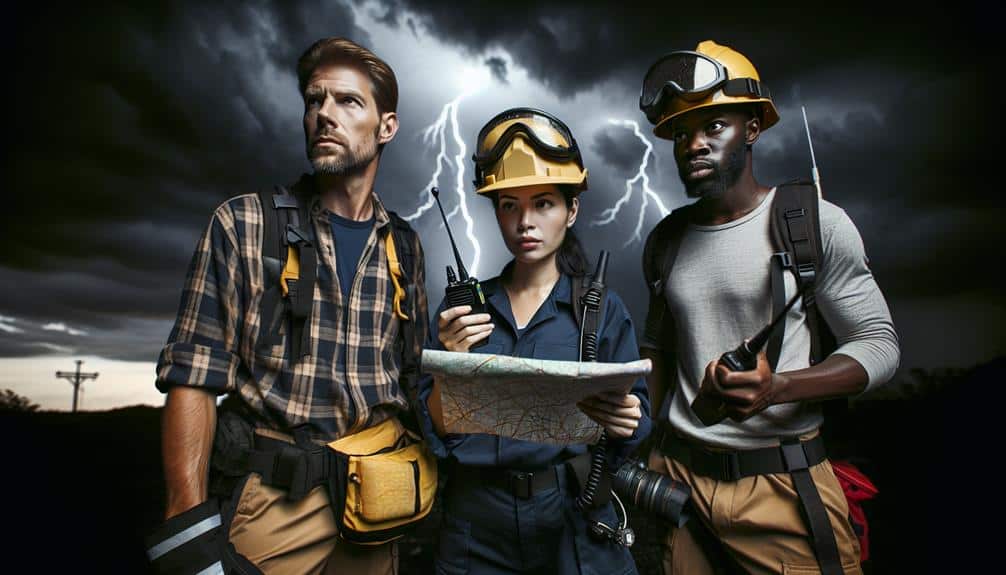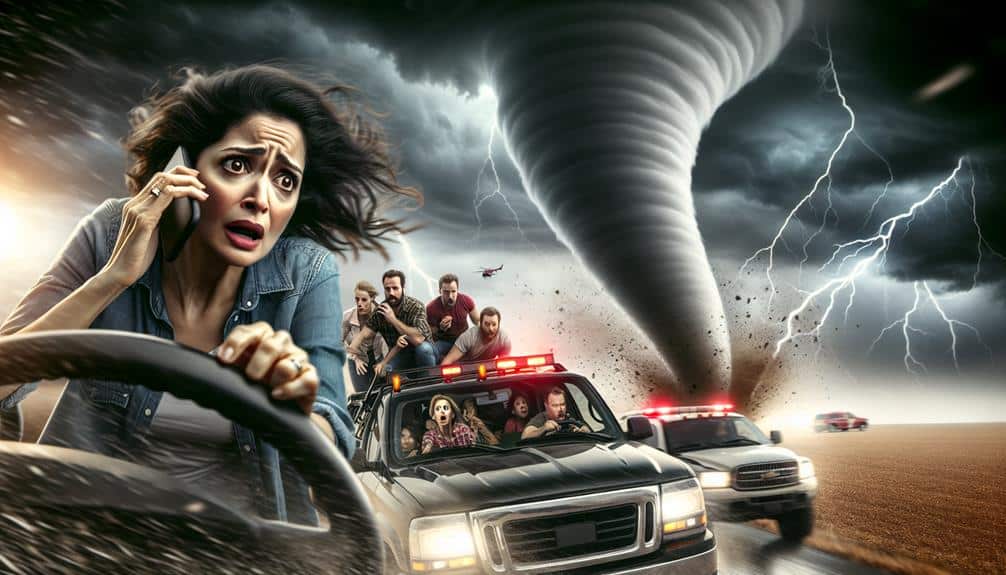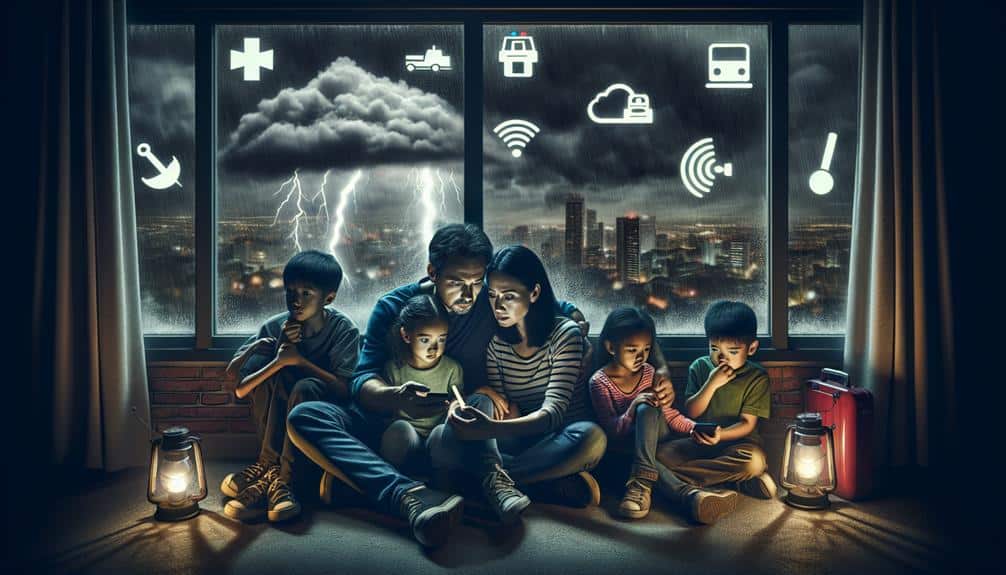Securing our safety in storm chasing hinges on precise, clear communication. Coordinated teams boast a 50% higher success rate, adhering to meticulously designed safety protocols. Real-time updates and high-frequency data streams are indispensable for monitoring evolving weather conditions and making informed, data-driven decisions. Advanced tracking technologies and constant communication via high-frequency radios or satellite phones further enhance our operational efficiency. Rigorous training and regular drills ensure every team member is proficient in their roles, bolstering readiness. By mastering these elements, we elevate our ability to track storms effectively and safely, providing critical insights into the intricacies of storm chasing.
Key Points
- Clear communication ensures adherence to safety protocols, preventing accidents and injuries during storm chasing operations.
- Constant communication via multiple channels allows real-time updates and quick decision-making based on evolving weather conditions.
- Effective communication streamlines emergency response, enabling rapid coordination and timely interventions in critical situations.
- Accurate relaying of GPS coordinates and meteorological data helps maintain precise tracking and positioning, enhancing team safety.
Importance of Coordination
Why is coordination crucial in storm chasing operations?
When we delve into the complexities of storm chasing, team coordination becomes paramount. Effective coordination guarantees that all members adhere to safety protocols, thereby minimizing risks. In an environment where seconds are critical, clear communication is non-negotiable. We can't afford errors when a tornado is on the horizon.
Data demonstrates that well-coordinated teams have a 50% higher success rate in safely tracking storms. This success depends on our ability to relay information seamlessly. Safety protocols dictate our actions, from positioning vehicles to deploying weather instruments.
For example, if we fail to communicate a sudden change in storm direction, it could result in disastrous outcomes.
Furthermore, emergency response is streamlined when team coordination is at its peak. In the event of an unforeseen incident, clear communication enables us to carry out rescue operations swiftly and efficiently. Our freedom to chase storms safely is directly linked to how effectively we adhere to these coordination principles.
Essentially, the analytical approach we take ensures that our operations aren't only successful but also conducted with the highest regard for safety. This structured coordination forms the backbone of our storm-chasing endeavors.
Real-Time Updates
Real-time updates are crucial for storm chasing teams to make informed decisions and adjust strategies on the fly. By leveraging high-frequency data streams, we can monitor evolving weather conditions and issue immediate safety alerts to team members. Accurate, up-to-the-minute information is paramount in ensuring our safety and optimizing our response to severe weather phenomena.
Our communication protocols are designed to facilitate rapid dissemination of real-time updates. We utilize advanced meteorological software and satellite feeds to gather data, which is then communicated through secure, encrypted channels. This guarantees that every team member, regardless of their location, receives the same information simultaneously, reducing the risk of miscommunication.
Additionally, we employ GPS tracking to keep tabs on each vehicle's position relative to the storm's path. This enables us to issue specific safety alerts based on real-time data, such as imminent tornado formation or flash flooding risks. By integrating these updates into our operational framework, we can make split-second decisions that enhance both our safety and our ability to collect valuable scientific data.
In essence, real-time updates aren't just a convenience but a necessity. They empower us with the freedom to act swiftly and confidently in the face of nature's most unpredictable forces.
Protocols and Procedures
Our protocols and procedures are meticulously designed to ensure every team member understands their role and responsibilities during storm chasing operations. We implement stringent safety protocols to protect our team while maximizing data accuracy.
Each member is briefed on specific tasks, guaranteeing seamless team coordination. Our communication strategies are critical; we use predefined signals and codes to maintain clarity, especially during high-stress scenarios.
We conduct regular drills to reinforce these procedures, simulating various storm conditions to evaluate our readiness. Data accuracy is paramount; hence, we double-check all readings before transmission. This practice minimizes errors that could compromise both safety and the quality of our research.
Our protocols mandate constant communication via multiple channels, including radio, satellite, and mobile networks. This redundancy assures that even if one system fails, we stay connected. Each team member is equipped with GPS trackers, allowing real-time monitoring of their positions to adjust strategies dynamically.
We also incorporate real-time weather updates into our procedures, enabling us to make informed decisions quickly. By adhering to these meticulously crafted protocols and procedures, we secure not only our safety but also the integrity and reliability of our storm chasing endeavors.
Use of Technology
In storm chasing, we've seen significant advancements through real-time data access, advanced tracking systems, and enhanced communication tools. These technologies enable us to make data-driven decisions with greater accuracy, improving both safety and effectiveness.
Real-Time Data Access
Accessing accurate and up-to-date meteorological data is crucial for storm chasers to make informed decisions and ensure safety. We depend on real-time data to evaluate storm development, track movement, and predict potential hazards. Data precision is paramount; it guarantees our observations translate into actionable insights.
When data is timely and precise, we can implement effective safety protocols, minimizing risk to our team and others. Technological advancements have transformed our ability to acquire and analyze meteorological data. We use high-resolution radar, satellite imagery, and real-time weather models to monitor storm activity.
Mobile internet connectivity enables us to access these tools on the move, providing a continuous flow of essential information. Our decisions are data-driven, and we harness this information to adjust our strategies in real-time.
Advanced Tracking Systems
How do advanced tracking systems revolutionize our storm chasing capabilities with precise technology and real-time analytics?
By leveraging cutting-edge radar, satellite data, and GPS, we greatly enhance our tracking accuracy. These systems provide us with high-resolution data, enabling us to pinpoint storm locations and movements with unprecedented precision. As a result, we can make more informed decisions on the ground, notably improving our safety margins.
Moreover, the integration of machine learning algorithms allows us to analyze vast datasets in real-time. This leads to improved forecast reliability, as we can predict storm paths and intensities with greater confidence. The real-time analytics offered by these advanced systems mean we can adapt our strategies on the fly, ensuring we're always in the best position to observe and document severe weather phenomena.
The freedom that comes with knowing we've reliable, accurate data can't be overstated. It allows us to push the boundaries of storm chasing while maintaining a high level of safety. By embracing these technological advancements, we enhance our ability to study and understand these powerful natural events, contributing valuable insights to the broader meteorological community.
Enhanced Communication Tools
By leveraging state-of-the-art communication tools, we can seamlessly share real-time data and coordinate our storm chasing efforts with pinpoint accuracy. The integration of enhanced technology directly translates to communication efficiency, improving our safety in unpredictable conditions.
High-frequency radios, satellite phones, and mobile data hotspots enable us to maintain constant contact with our team members and emergency services, ensuring that we're always one step ahead of the storm.
Utilizing advanced weather apps and GPS tracking systems, we can relay precise coordinates and meteorological data instantaneously. This enhanced technology fosters better coordination, allowing us to execute strategic maneuvers that minimize risk.
For instance, radar applications with live updates enable us to predict storm paths more accurately, thereby informing our decisions on positioning and movement.
Additionally, cloud-based platforms facilitate the sharing of large datasets across multiple devices, ensuring that every team member has access to the latest information. These tools also empower us to collaborate with meteorologists and other storm chasers in real-time, further enhancing our situational awareness and decision-making capabilities.
Emergency Contacts

Keeping an updated list of emergency contacts guarantees swift communication and coordination during pivotal moments in storm chasing. We must prioritize contact verification to confirm that every number and email in our communication plans is accurate and current. By doing so, we reduce the risk of information delays or miscommunications that could compromise our safety.
Our communication plans should include pre-designated roles among team members to streamline the process. Each person should know who to contact in the event of an emergency, whether it's local authorities, meteorological services, or medical teams. This structured approach facilitates a rapid emergency response, ensuring help arrives when and where it's needed most.
Family notification is another crucial aspect. We need to have a reliable method to inform family members of our status during a chase. This guarantees they're not left in the dark and can provide necessary information to emergency responders if required.
An efficient emergency contact system not only safeguards our physical well-being but also supports the emotional security of our loved ones. In storm chasing, where unpredictability is the norm, such structured communication frameworks empower us to operate with both freedom and safety.
Information Accuracy
We must prioritize information accuracy by relying on reliable data sources and ensuring real-time updates. Our protocols for fact-checking are essential to validate the data we communicate during storm chasing.
Accurate information enables us to make informed decisions and enhance safety measures.
Reliable Data Sources
Accurate information from dependable data sources is vital for storm chasers to make informed decisions and safeguard their safety. Without precise data on weather patterns, we can't predict storm trajectories or intensities effectively. This data is our lifeline, enabling us to navigate the volatile and often treacherous environments we encounter. We rely heavily on meteorological models, satellite imagery, and radar data to analyze atmospheric conditions. These tools help us identify supercell formations, potential tornado genesis, and other severe weather phenomena.
Moreover, having access to accurate data is essential for coordinating emergency response efforts. We need to make sure that our observations and reports are consistent with those from trusted agencies like the National Weather Service (NWS) and the Storm Prediction Center (SPC). Their validated data provides a benchmark against which we can measure our own findings, allowing for a higher degree of precision in our operations.
Utilizing reliable data sources supports our intrinsic desire for freedom—freedom to chase storms safely, to contribute meaningfully to scientific research, and to assist in life-saving emergency response operations. In this high-stakes field, dependable information is indispensable for both our personal safety and the broader community's well-being.
Real-Time Updates
Real-time updates are vital for maintaining the accuracy of our situational awareness during storm chasing missions. When we're in the field, the dynamic nature of severe weather requires us to stay informed with the most current data to make informed decisions. Accurate weather forecasting and adherence to safety protocols hinge on up-to-date information.
Utilizing real-time updates provides several advantages:
- Immediate Hazard Recognition: We can quickly identify and react to emerging threats, minimizing our exposure to risky conditions.
- Adaptive Route Planning: With continuous data streams, we can adjust our paths to avoid severe weather, optimizing both our safety and efficiency.
- Enhanced Communication: Real-time updates facilitate better coordination among team members, making certain that everyone is on the same page and can respond promptly to changes.
In storm chasing, the margin for error is narrow. Real-time weather forecasting data allows us to maintain a high level of situational awareness, which is essential for implementing safety protocols effectively. By leveraging technology for real-time updates, we empower ourselves to make swift, informed decisions that secure our safety and the success of our missions.
Fact-Checking Protocols
Maintaining the integrity of our data becomes essential, ensuring rigorous fact-checking protocols to guarantee information accuracy in our storm chasing missions. We implement a stringent verification process, confirming each data point we collect undergoes meticulous scrutiny. This involves cross-referencing real-time observations with historical data and satellite imagery, enhancing our confidence in data accuracy.
Our verification process begins with initial data collection, utilizing advanced meteorological instruments and software. Once data is gathered, we employ automated algorithms to detect anomalies and flag inconsistencies. This preliminary analysis is followed by manual verification from our experienced team, who carefully review the data to confirm its validity. We prioritize transparency in our methods, allowing us to maintain the highest standards of accuracy.
Data accuracy is vital not only for our safety but also for providing reliable information to the broader scientific community and the public. Accurate data enables us to make informed decisions, predict storm behaviors more precisely, and communicate effectively with emergency services.
Training and Drills

Intensive training and regular drills are necessary to guarantee that storm chasers can execute effective communication protocols under high-pressure conditions. We must make certain our team is prepared to handle the unpredictable nature of storm chasing, and this begins with rigorous preparation.
To enhance our readiness, we focus on:
- Simulation exercises: By recreating real-world scenarios, we can practice our responses to various storm conditions. These exercises help us refine our communication strategies and ensure everyone knows their role.
- Safety protocols: Regular drills ensure that safety procedures are second nature. We practice evacuation routes, emergency signal procedures, and first aid responses to maintain a high standard of operational safety.
- Technology proficiency: Mastery of communication tools and weather tracking devices is pivotal. We conduct drills to familiarize ourselves with the latest technology, ensuring that we can relay information quickly and accurately.
These components are essential for maintaining a cohesive team dynamic, especially when faced with the high-stakes environment of storm chasing.
Frequently Asked Questions
How Can Storm Chasers Stay Safe While on the Field?
We can stay safe on the field by implementing robust emergency protocols, employing effective communication strategies, and ensuring seamless team coordination. Regular weather updates enhance situational awareness, enabling us to make data-driven decisions in dynamic conditions.
What Personal Protective Gear Should Storm Chasers Wear?
For the Current Question, we should prioritize proper attire and safety equipment like helmets, goggles, and sturdy boots. Data shows that wearing these greatly reduces injury risk, ensuring we can chase storms while maintaining our freedom and safety.
How Do Storm Chasers Handle Sudden Changes in Weather Conditions?
We adapt our strategies by constantly monitoring weather forecasting data. When sudden changes occur, we quickly analyze radar updates and satellite imagery to reposition ourselves efficiently, ensuring we're always in the best possible location to observe safely.
What Type of Vehicles Are Best Suited for Storm Chasing?
When considering vehicle selection for storm chasing, we prioritize safety measures. SUVs and trucks with reinforced structures and advanced weather tracking technology are ideal. They offer mobility, durability, and real-time data access, ensuring we navigate safely.
How Do Storm Chasers Manage Mental and Physical Stress During Missions?
We tackle mental and physical stress by visualizing calm scenes, employing stress management techniques like deep breathing, and maintaining mental health through resilience building. These coping strategies help us stay focused and adaptable during intense storm chasing missions.


